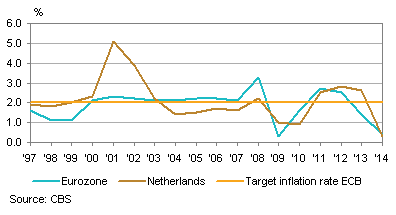inflation rate 2014 lowest in more than 25 years

Statistics Netherlands announced today that the average inflation rate over the year 2014 was 1 percent. The price increase for products and services Dutch consumers bought last year is the smallest increase in more than 25 years. Prices of many products and services have hardly risen last year, but rents rose rapidly in 2014.
Inflation rate exceptionally low
Following a period of high inflation, the rate over 2014 was exceptionally low. The inflation rate over 2013 averaged 2.5 percent. In 2013, inflation was seriously affected by tax increases. The inflation rate over the past 25 years averaged 2.2 percent.
Inflation in percentages

Considerable rent and tax increases force up inflation in 2014
The residential rent increase (link huurbeleid) contributed most to inflation in 2014. The average rent increase was more than 4 percent in 2014 compared to 2013. Higher tax rates also contributed to inflation. Road tax, for example, was raised considerably in January 2014. If rent and tax increases are not taken into account, the inflation rate would be -0.1 percent.
Inflation higher if gas, electricity and motor fuels are not taken into account
Inflation was curbed last year because gas, electricity and motor fuels became much cheaper. Energy prices are strongly affected by developments on the global market. Therefore, inflation is often calculated excluding volatile energy prices. In 2014, the gap between these two benchmarks averaged 0.2 percentage points. In the latter half of 2014, the gap widened to 0.5 percentage points as a result of rapidly declining oil prices.
Inflation and inflation excl. energy in percentages

Price level many products and services stable
Prices of many products and services remained stable in 2014. As producers did not raise their prices and collectively negotiated wages rose only marginally, there was no reason for a significant consumer price increase.
Collectively negotiated wage increase equals inflation
During the recent economic recession, the collectively negotiated wage increase has been below the level of inflation, but when inflation started to fall, the gap between the collectively negotiated wage increase and inflation narrowed. If collectively negotiated wages increase or decrease, this will not have an immediate effect on the purchasing power of employees. After all, net wages also depend on changes in social contributions, contributions to pension funds and wage tax.
Inflation and collective wage increases (CAO) in percentages

Inflation in the Netherlands lower than in the eurozone
To facilitate comparison between the inflation rate in the Netherlands and the rates in other countries, Statistics Netherlands also publishes data on inflation calculated according to the European harmonised method (HICP). Dutch inflation based on the HICP method averaged 0.3 percent over 2014, i.e. the lowest rate since the HICP method was introduced in 1997. The eurozone inflation rate on an annual basis was 0.4 percent, the lowest rate since 2009.
The inflation rate across the eurozone is an important guideline for the European Central Bank (ECB) to decide if the interest rate should be changed. According to the ECB, prices are stable if inflation across the eurozone is close to 2 percent.
Inflation according to the HICP in percentages
